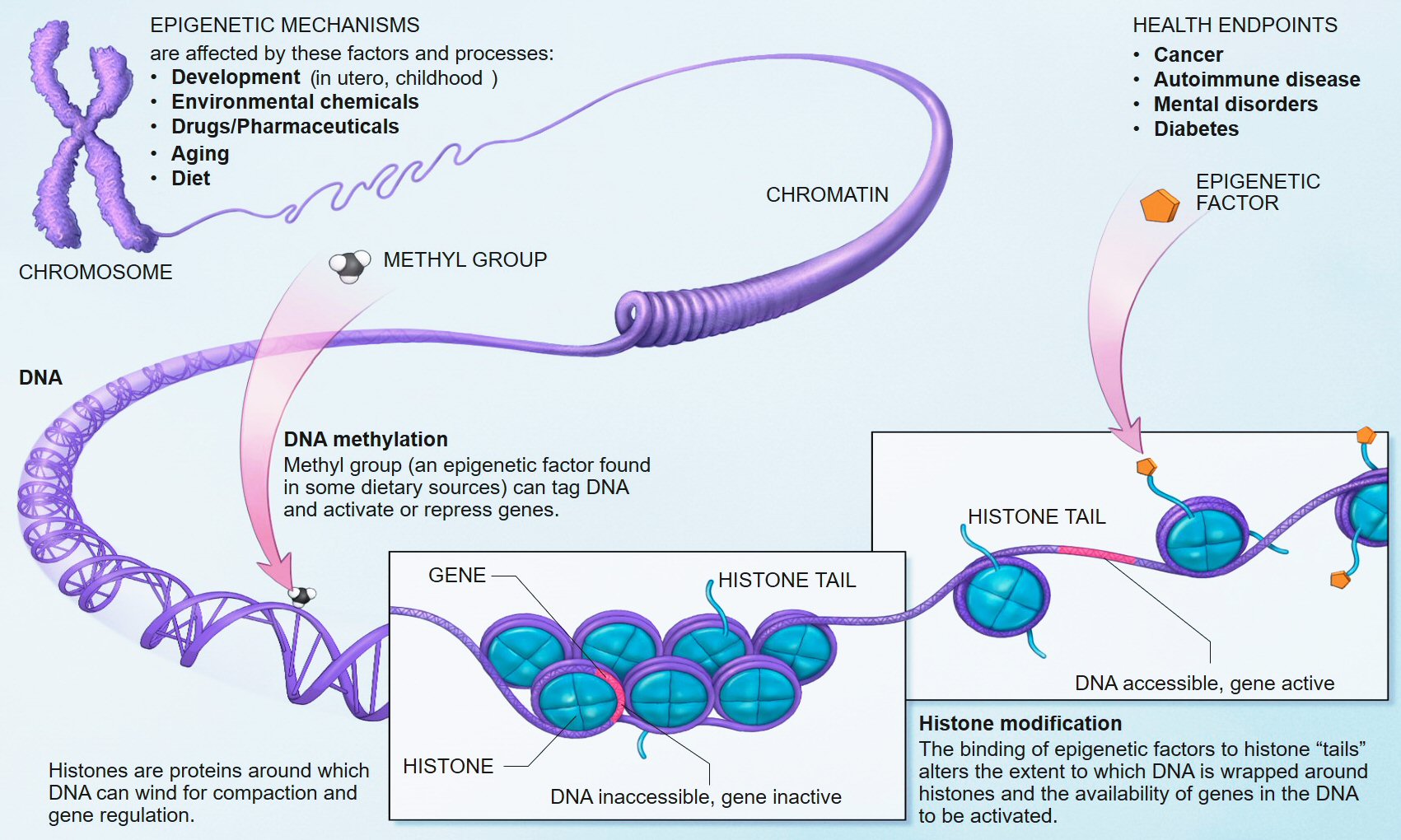Sure, epigenetics (as a word) was coined some 400 years ago. But, it really wasn’t until the 1990s that we had a good handle on what it really is- and we’re still learning about what it really means.
Before I discuss epigenetics, I need to define two other terms. Phenotype and genotype.
The genotype is our actual genetic makeup (or the genes of a given organism). This is the hereditary information we associate with our 23 pairs of genes that are inherited from our parents. (That is our genetic code- and changes to the genetic code are called mutations.)
The phenotype is comprised of all the observable characteristics and traits that we have. And, it turns out a lot of our phenotype data is inheritable.
 Epigenetics is the study of our heritable phenotype changes. There are no changes to our DNA sequences that are associated with changes in our phenotypes.
Epigenetics is the study of our heritable phenotype changes. There are no changes to our DNA sequences that are associated with changes in our phenotypes.
Now that we have our terminology straight, we can talk about why exercise improves our cognitive skills- it changes our phenotypes. Yes, that also means some of those changes are heritable.(I have written often about the enhancement of our memory and thought processes by exercise. Here’s but one example.)
These factors are exactly why clinicians are prescribing exercise to Parkinson’s and Alzheimer’s sufferers (as well as those suffering from anxiety or epilepsy). These neurodegenerative diseases manifest improvements due to exercise.
Back in the 1990’s, Rusty Gage (now the President) of the Salk Institute of Biological Studies (La Jolla, CA) had determined that mice that exercised developed additional neurons in their hippocampus (the brain region that is instrumental to learning and memory). His post-doc, Henriette van Praag, tried to ascertain what sort of exercise and exercise toys could manifest the greatest number of changes. (It turns our it was the mice wheel- which is why van Praag took up running. Van Praag is now at the FAU [Florida Atlantic University] Brain Institute.)
Eventually, we found that it was the level of neutrophin (a protein that stimulates the proliferation of neurons and their functionality) to serve as the critical issue. The Bdnf gene has a promoter region that is enhanced by physical activity (DNA demethylation); and maybe histone acetylation (chromatin release) also bolsters Bdnf transcription.
It turns out it isn’t just neuron stimulation- but cognitive plasticity and synaptic plasticity that are enhanced with exercise. And, Bdnf manages to traverse the blood-brain barrier, which activates or inhibits the epigenetic markers in brains.
A few years ago, van Praag and her cohorts at FAU determined that cathepsin B (a protein) is secreted by muscle cells during exercise. That is what spurs the neurogenesis. (This is also true in humans And after some four months of treadmill exercise [thrice weekly, 45 minutes duration or longer], these humans were capable of better memory than when the program started before they began their exercise regime.)

Another cool finding? Exercise by pregnant women helps their baby’s brains develop. Children of moms who exercised regularly during pregnancy had higher oral language and general intelligence skills than those from moms who didn’t exercise. (Dr. James Clapp III, Case Western, Journal of Pediatrics.)
Dr. Rudolph Tanzi (Mass General, Harvard Med), Fred Gage (Salk), and Henriette van Praag (FAU), along with 17 other clinicians determined that the body can mimic the effects of exercise via chemicals. (Combined adult neurogenesis and Bdnf mimic exercise effects on cognition in an Alzheimer’s mouse model as they reported in Science)
They recognized that Alzheimer’s destroys the neurons and synapses in the brain, but simply enhancing neurogenesis alone did not reverse that situation; one has to mediate the neuronal environment. (Neither a neuroprotective drug nor gene therapy could enhance the production of WNT3 (neurogenesis is associated with this protein).
However, if they combined a neuroprotective drug with one that forced the Bdnf gene to be expressed, one could match the results achieved by mice running on the wheels.)
This means we may be able to develop a drug to treat Alzheimer’s patients who are unable to exercise.
Now, wasn’t that information worth learning about epigenetics, phenotype, and genotype?







Yes, this was worth the read, having lost a cousin to Parkinson’s and seeing what dementia did to my mother in law.
Glad you found it useful, Alana!
Thanks a lot for sharing, I am constantly doing the exercises
Glad that you are! Thanks for the visit and the comment.